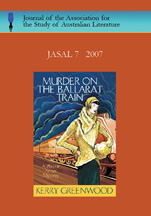Shadow on Screen The Wayang Kulit in The Year of Living Dangerously
Keywords:
Christopher Koch, The Year of Living Dangerously, wayang kulit, gamelan, dalang, Indonesia, Java, Sukarno, Suharto, film, Peter Weir, post-colonialism, postcolonialism, politics, representation, adventure fiction, journalismAbstract
The Year of Living Dangerously is perhaps the clearest example of Koch’s engagement with Asia. In this novel the wayang kulit, the Javanese shadow-puppet play, is used for a variety of purposes. It appears at crucial points within the narrative, and also serves as an overall structuring device for the novel. It frames the novel’s main plot, which depicts the last days of the Sukarno regime in 1965 and the coup which brought Indonesia to the brink of crisis. Furthermore, the characters of the wayang are used as archetypes for the characters in the novel, which creates space for reflections on stereotyping and the complicity of Western characters in the instability and violence experienced by Indonesia. Ultimately, the wayang is a motif and device of narrative and characterisation which allows Koch to explore notions of power and the abuse of power in a post-colonial context.Downloads
Published
2008-03-05
Issue
Section
Articles
License
The copyright for articles in this journal is retained by the author(s), with first publication rights granted to the journal. By virtue of their appearance in this open access journal, articles are free to use with proper attribution in educational and other non-commercial sectors.Attribution-NonCommercial-ShareAlike 2.1 Australia
This work is licensed under the Creative Commons Attribution-NonCommercial-ShareAlike 2.1 Australia License. To view a copy of this license, visit http://creativecommons.org/licenses/by-nc-sa/2.1/au/ or send a letter to Creative Commons, 543 Howard Street, 5th Floor, San Francisco, California, 94105, USA.
How to Cite
Shadow on Screen The Wayang Kulit in The Year of Living Dangerously. (2008). Journal of the Association for the Study of Australian Literature, 7, 46-58. https://openjournals.library.sydney.edu.au/JASAL/article/view/9712

